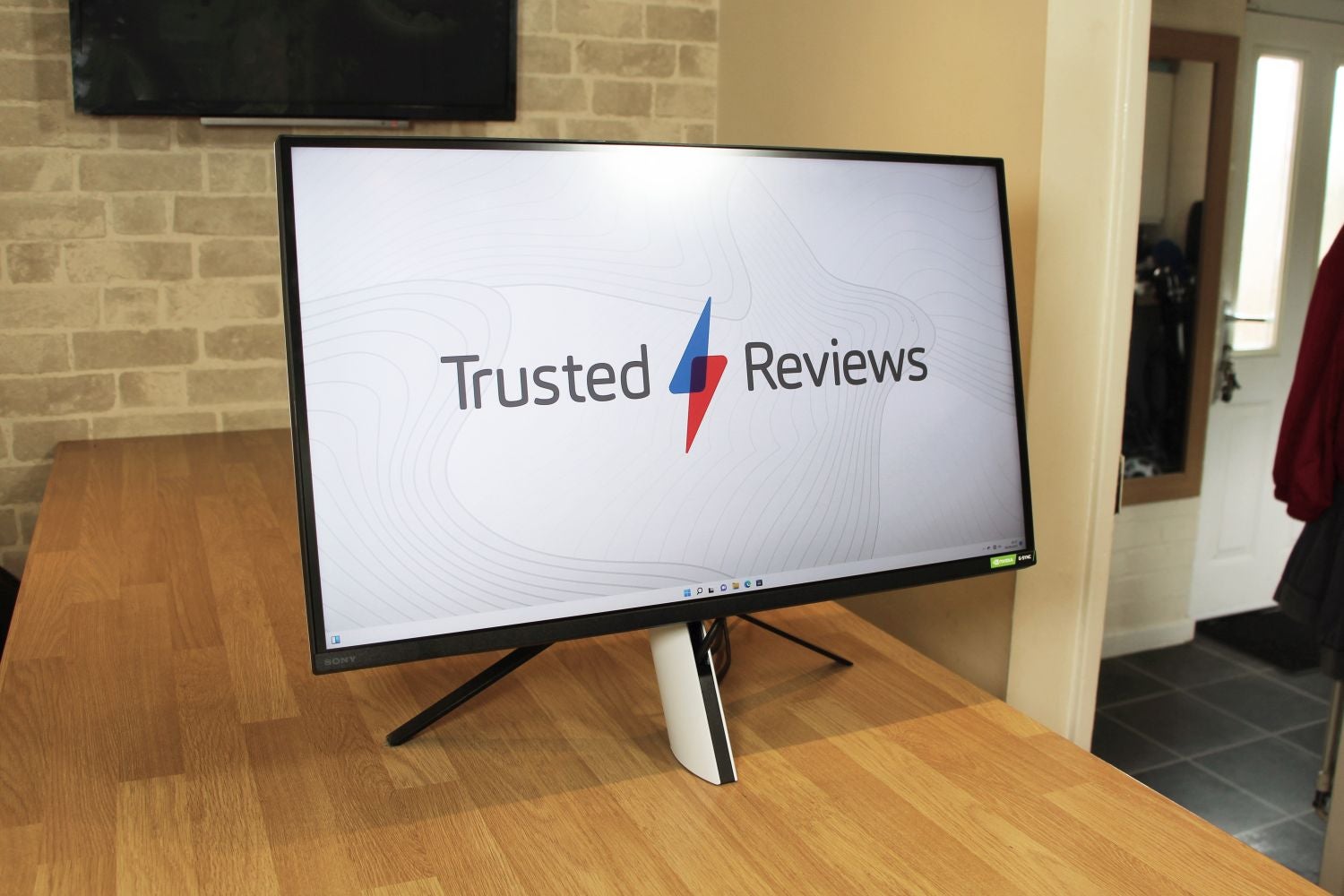Sony’s first gaming monitor delivers bold, punchy imagery with more HDR clout than you’ll find on most gaming displays, alongside a sleek design. But its poor adjustment, connectivity and audio disappoint, and you’ll find added quality from rivals that don’t cost much more.
Pros
- Bold, vibrant imagery in games
- Sleek, good-looking design that matches the PS5
- Impressive HDR ability thanks to FALD
- Lots of ports
Cons
- Colour accuracy could be better
- Ports are tricky to reach
- Poor adjustment options
- Disappointing speakers
Availability
- UKRRP: £999
- USARRP: $899
- EuropeRRP: €1098
-
A 27in, 4K gaming displayThe 27in diagonal and 4K resolution combine to create a crisp gaming experience on PC and console, although you’ll need to sit close to the display to get the most out of the Sony -
Full Array Local Dimming The inclusion of 96 dimming zones helps the Sony deliver better HDR performance than the vast majority of gaming screens – although Mini LED and OLED panels are better still. The screen will also automatically apply the correct HDR settings if you load a compatible game on your PS5 -
A 144Hz refresh rate with Nvidia G-SyncThe 144Hz refresh rate sits alongside Nvidia G-Sync and ensures that you get butter-smooth gaming in big-name games
Introduction
The Sony Inzone M9 is the first gaming monitor from the entertainment giant, and there’s no doubt that this display must impress; when there are companies such as Samsung snapping at your heels, you don’t want to release a dud.
The Sony needs to perform well to encourage folk to part with their cash, too – because its price of £999 / $899 / €1099 makes it more expensive than many of its rivals.
However, for that outlay you do get an eye-catching design, a 4K resolution and proper local dimming – so, on paper, it appear that it will make games look amazing. And if the Sony can deliver on that promise, it might be able to jump ahead of displays such as the Samsung Odyssey Neo G8 for a place on our best gaming monitor chart.
Design and Features
- A good-looking display
- A 4K resolution and 144Hz refresh rate alongside FALD for HDR
- Lack of adjustment options and poor speakers undermine
There’s no mistaking the M9 as a Sony product – its stand and rear panel share the black and white plastic aesthetic of the PS5 console, pads and accessories. The M9 doesn’t just draw attention as a result of its colouring, though. Its triple-pronged stand looks different to every other gaming display on the market, with one leg pointed forwards while two more extend backwards to keep the screen stable.
The tall, slim legs look good and, Sony says, they’re designed to give users more space on their desk. They work well in that regard.
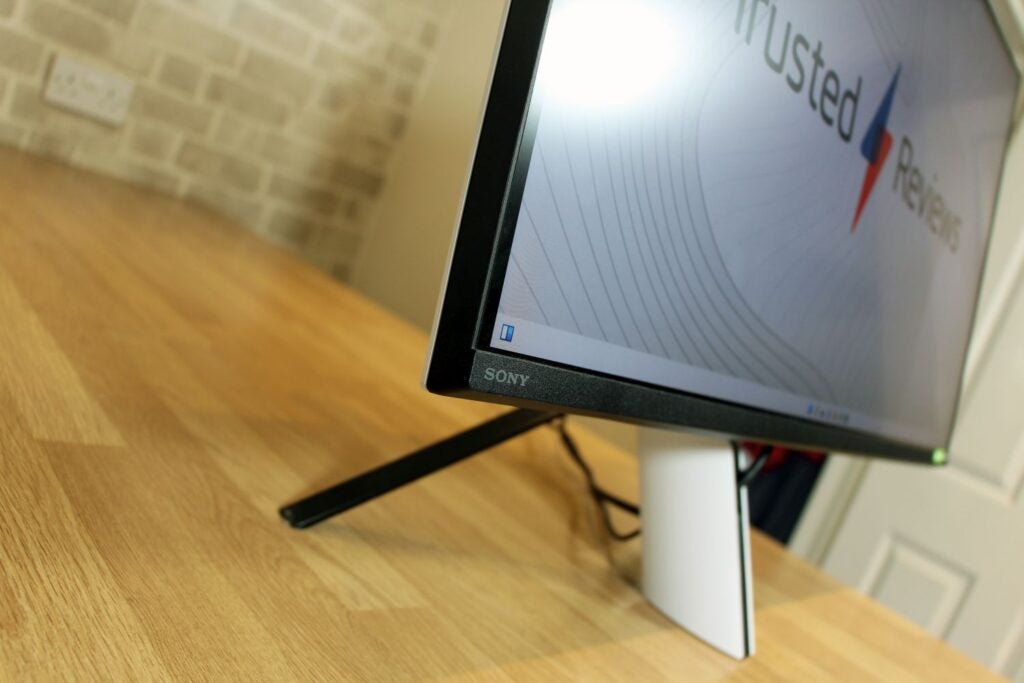
It’s an impressively sturdy display, too, with build quality you’d expect from a screen at this price. That’s even better when you consider that the M9’s 6.8kg is modest for a high-end 27-inch screen.
The quality continues on the inside. Sony’s IPS pairs a 4K resolution with a 27-inch diagonal, which means a stonking density level of 163ppi. That’s high, and means games look pin-sharp – although you’ll have to sit close to the screen to get a good experience. The M9 suits people who want to game at the desk or in a bedroom – rather than those sat further away on the sofa.
The 4K resolution sits alongside a 144Hz refresh rate that supports Nvidia G-Sync and AMD FreeSync, so it will work with any graphics card as long as it has the grunt to handle 4K games at frame rates of 144fps.
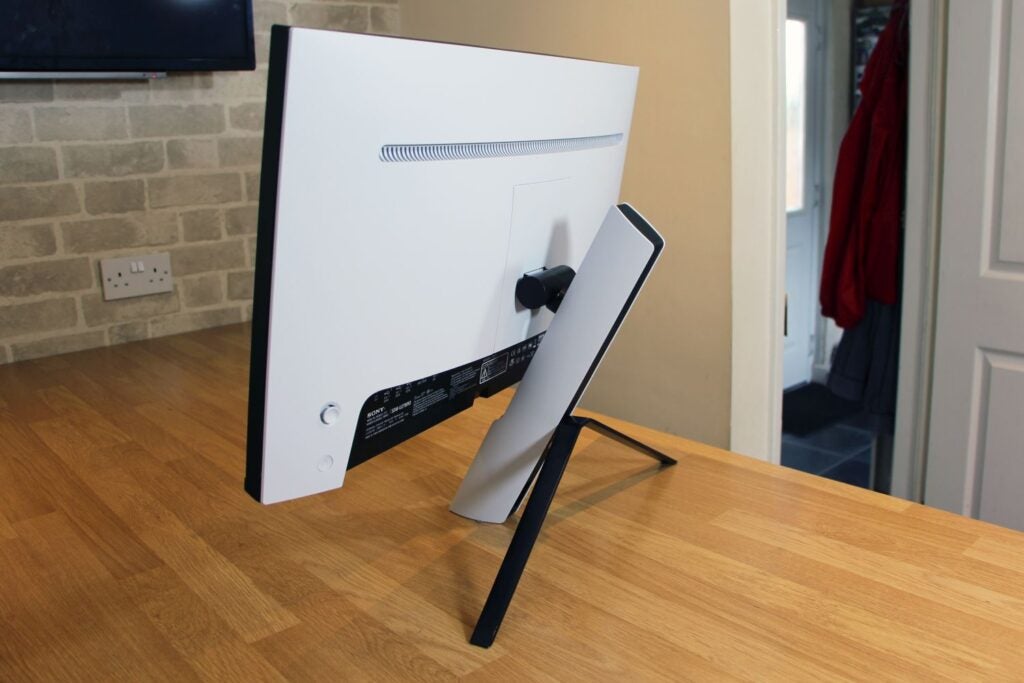
Elsewhere, the M9 deploys a 1ms response time and 10-bit colour, and its support for VESA DisplayHDR 600 is bolstered by its inclusion of 96 Full Array Local Dimming zones. That’s a better HDR specification than most gaming monitors that only use edge-lit backlighting, but it’s still unable to compare with proper OLED devices.
It might struggle when up against the Samsung, too. That display uses 1196 Quantum Mini LEDs to deliver better backlighting complexity. Samsung’s screen outstrips the M9 in other areas, too: it runs at 240Hz, and it’s 32in wide with a 1000R curve.
The Neo G8’s better specification will cost you more, though: at the time of writing, the monitor was priced at £1299 / $1299 / €1299. But if you’re already thinking about spending almost four figures on a gaming screen, you might consider making the jump upwards.
That’s more likely when you check out some of the other features, since the M9 is a bit inconsistent. Positively, it works flawlessly with PS5 consoles: it automatically optimises its HDR settings depending on the game and switches between media and gaming modes on switching apps.
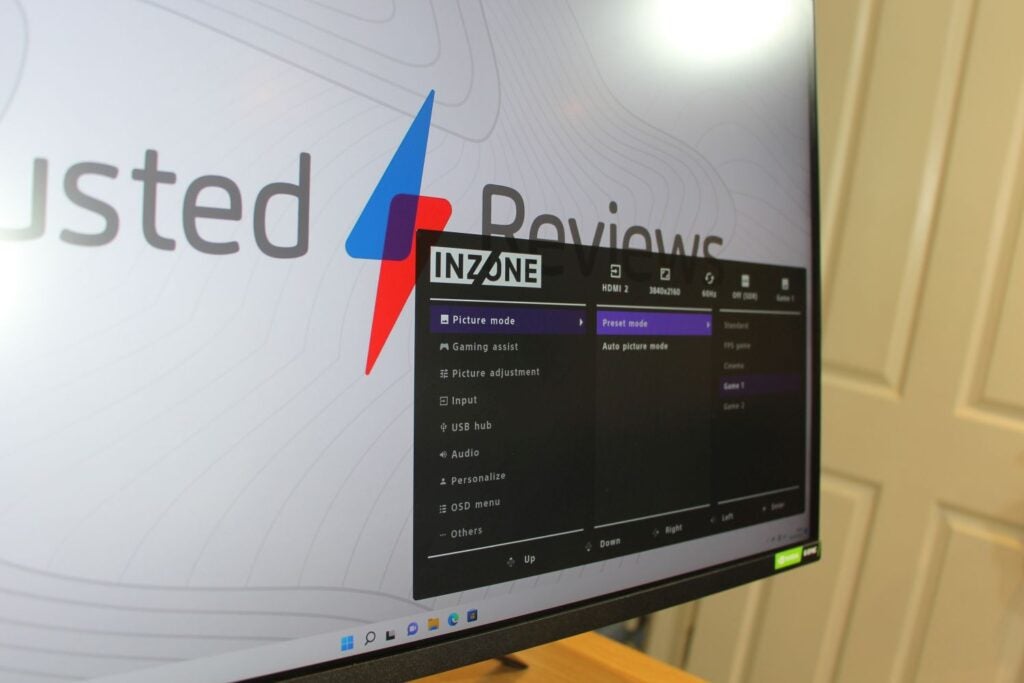
Around the back you’ll find a generous selection of ports. It has two HDMI 2.1 ports that are well suited to 4K/120Hz gaming on your PS5, alongside a DisplayPort socket. There’s a USB-C port that handles DisplayPort and three full-size USB connectors. There’s even a KVM, so you can control different devices with the same peripherals.
A straightforward joystick on the rear navigates the on-screen display, and the software is good – responsive, straightforward and packed with options, including USB hub adjustments, all of the usual screen tweaks and the option to add frame rate counters and crosshairs to your games. These options can be adjusted using a Windows app, too.
The M9 may have plenty of ports, but they’re difficult to reach. They all face downwards at the rear of the screen, and the stand blocks most of the actual display inputs. The cable-routing hole is tiny and fiddly, and you’ll need a screwdriver to assemble this display – always disappointing on a relatively small panel.
The three-pronged angular stand also offers a lack of adjustment options. The M9 delivers only 70mm of height adjustment alongside 20 degrees of tilt movement and 100mm VESA mount support, but there’s no portrait mode or swivel movement. And in a particularly miserly move, you don’t get HDMI, DisplayPort or USB cables.
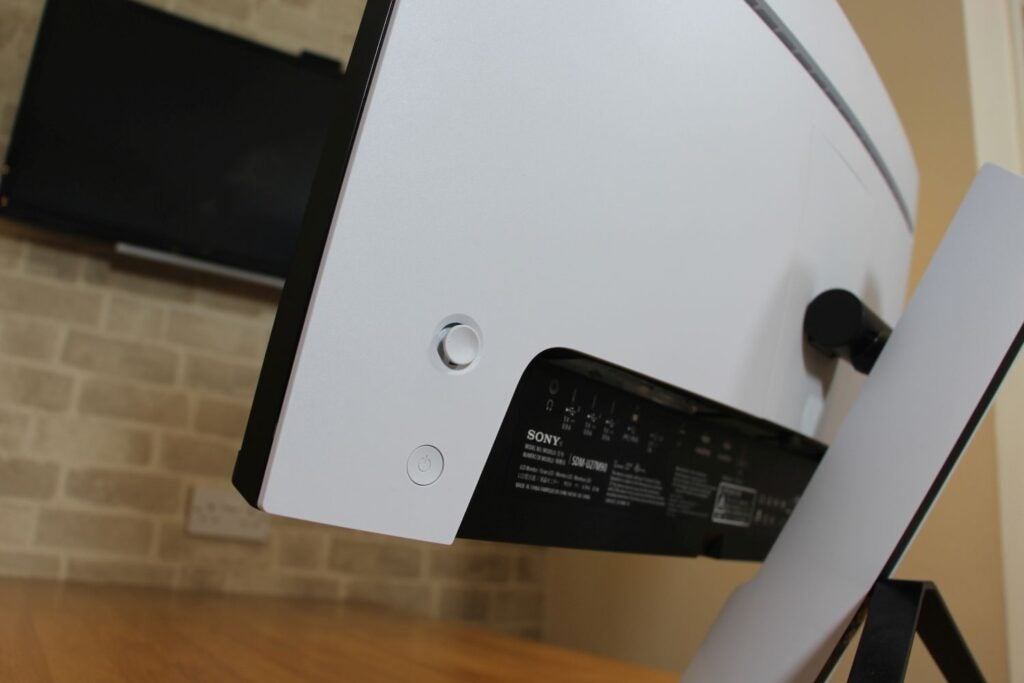
Don’t expect much from the speakers, either. The pair of 2W units here are tinny; they’re not particularly loud and display a near total lack of bass. Many people will use a headset or external speakers, but the fact that the audio provision is so poor on a screen that costs so much and is designed to sit alongside a PS5 is disappointing. Finally, there are the RGB LEDs – a row of them sit around the rear of the screen, but they’re not particularly bright or impactful.
There are some significant areas where the Samsung rival trades blows with the Sony. That larger display offers more adjustment options, including portrait mode functionality, and its ports are easier to access. It doesn’t have speakers, and the two offer similar connectivity and on-screen navigation.
Image Quality
- Great IPS contrast and vibrant, deep colours make games look excellent
- Motion is smooth and the 96 dimming zones supply solid HDR performance
- Samsung’s key rival uses Quantum Mini LEDs to exceed the Sony in most key categories
Sony’s panel delivered an initial brightness level of 205 nits alongside a black point of 0.12 nits – with the latter a great result for any IPS screen. The resulting contrast ratio of 1708:1 is one of the best scores I’ve seen from any IPS panel, and it enables the Sony to render games with plenty of depth.
Colours are good, if not quite as impressive. The Delta E of 3.99 is fine for gaming, but it isn’t particularly accurate – and the temperature of 7752K is on the cool side. While this screen produces 98.9% of the sRGB gamut with a hefty 126.9% volume, the temperature robs the display of some warmth.
Despite knowing that the colours sit on the blue-tinged side of the spectrum, the Sony does a great job with games. The 4K resolution keeps them sharp, the contrast ratio delivers impressive punch, and the colour temperature doesn’t have a huge impact; games are still bright and punchy.
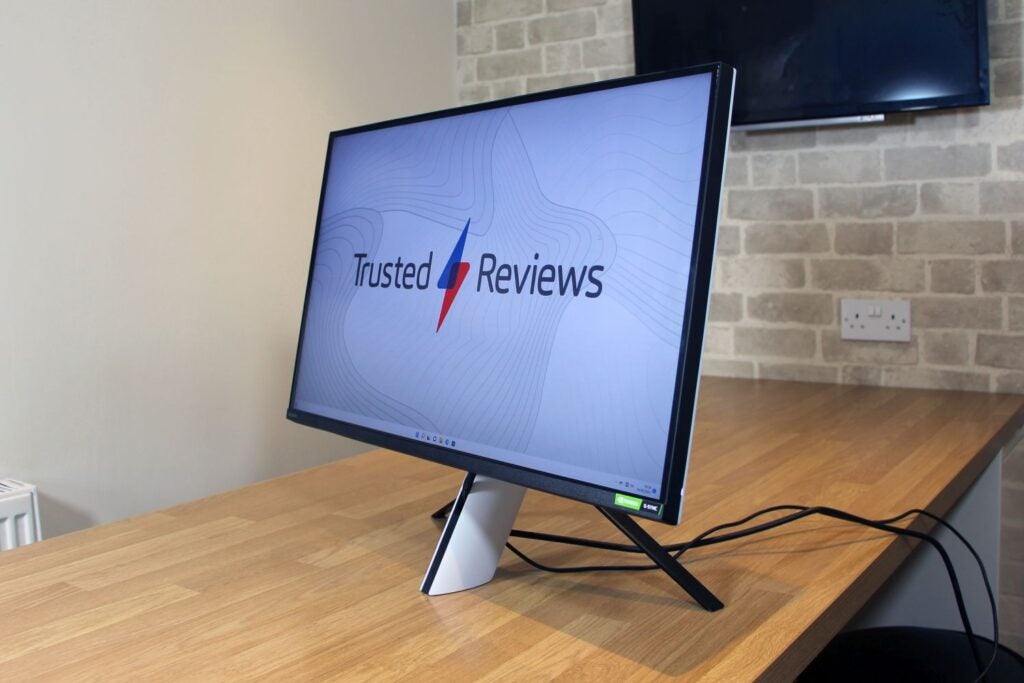
If you’re happy to lose a bit of contrast to gain more accurate colours, switch from the default gaming settings to the display’s standard operating mode – that option reduced contrast to a still-reasonable 1240:1 while improving the Delta E and colour temperature to 2.3 and 6346K. That mode is a decent alternative if you want realism rather than punch, or if you need to use the display for creative work alongside playing games.
Switch from SDR to HDR and you’ll have a good time. The backlight hit nearly 700 nits, and the panel rendered 88.6% of the DCI-P3 gamut – just enough for HDR gaming. Combine this with the 96 dimming zones and you have a display that delivers more subtlety and impact than most gaming monitors. There’s little else on the market that does this well at this price.
Sony’s screen did a decent job with motion, too. There are no big ghosting issues and only modest motion blur, which is exactly what I expect from a synchronised 144Hz panel. It’s ample to handle PS5 games and mainstream single-player titles on PC alongside casual competitive titles. That said, anyone who wants to play top-tier eSports games should use a 240Hz or 360Hz monitor.
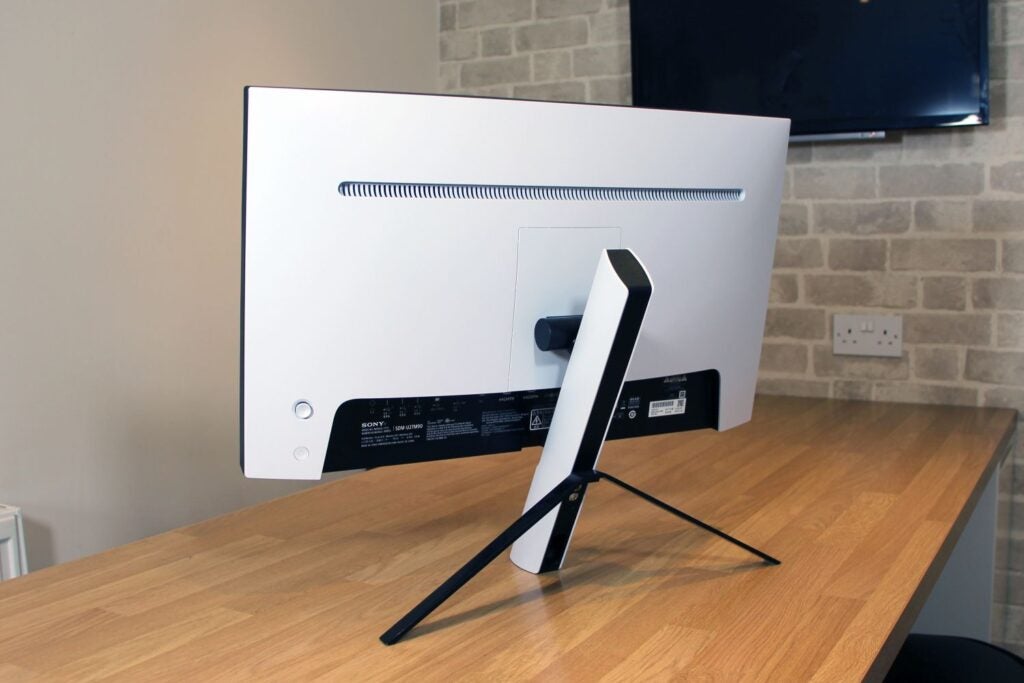
The M9’s response time isn’t quite good enough to tackle eSports gaming, either. In the Sony’s standard speed mode, its average response sits at around 9ms. In the Faster option that figure improves to about 5ms with hardly any overshoot. That’s fine for console and PC gaming and mainstream competition, but dedicated eSports screens will hover nearer to 1ms.
There’s lots to like here: the bottom line is that the Sony Inzone M9 will make PC and console games look great, delivering impressive contrast, depth, HDR performance and motion.
However, the Samsung’s Odyssey Neo G8 throws a spanner in the works. That screen might cost more, but its Quantum Mini LEDs deliver better contrast, more punch and improved HDR abilities. Its 240Hz refresh rate ensures smoother performance in a broader range of games, and its colour delivery is better too.
The presence of the Samsung certainly isn’t a deal-breaker for the Sony: the Inzone M9 makes games look great, plus it delivers a sleek design, some handy features and a good core specification. But if you’re happy to spend more and you’re not fussed about your monitor matching your PS5, the larger Samsung is better in almost every department.
Latest deals
Should you buy it?
You’d like a vibrant, sharp 4K screen to match your PS5 There’s no doubt that the M9 is a great companion to the PS5, and beyond the console it delivers the colours, contrast and HDR ability to make PC games look excellent, too.
You’d like a bigger screen with a broader range of features The M9’s 27-inch diagonal isn’t particularly large, and if you spend a little more cash then you can pick up a screen that offers better refresh rates and greater adjustment – so you’ll get improved eSports pace and extra versatility.
Final Thoughts
The Sony Inzone M9 deploys a high resolution, great colours and impressive contrast to make PS5 and PC games look superb – all packaged in a sleek design. But it isn’t cheap, and if you shop around you’ll find rivals with beefier specifications, better speakers and more adjustment options.
How we test
We use every monitor we test for at least a week. During that time, we’ll check it for ease of use and put it through its paces by using it for both everyday tasks and more specialist, colour-sensitive work.
We also check its colours and image quality with a colorimeter to test its coverage and the display’s quality.
We use as our main monitor for at least a week
We used a colorimeter to get benchmark results.
Used our own expert judgement for image quality
FAQs
The Inzone M9 is protected by a one-year warranty.
The M9 is sold with its power supply and cable, all of its paperwork and an Inzone sticker – but no display or USB cables.
Trusted Reviews test data
Jargon buster
Refresh Rate
The number of times the screen refreshes itself per second.
Sony’s first gaming monitor delivers bold, punchy imagery with more HDR clout than you’ll find on most gaming displays, alongside a sleek design. But its poor adjustment, connectivity and audio disappoint, and you’ll find added quality from rivals that don’t cost much more.
Pros
- Bold, vibrant imagery in games
- Sleek, good-looking design that matches the PS5
- Impressive HDR ability thanks to FALD
- Lots of ports
Cons
- Colour accuracy could be better
- Ports are tricky to reach
- Poor adjustment options
- Disappointing speakers
Availability
- UKRRP: £999
- USARRP: $899
- EuropeRRP: €1098
-
A 27in, 4K gaming displayThe 27in diagonal and 4K resolution combine to create a crisp gaming experience on PC and console, although you’ll need to sit close to the display to get the most out of the Sony -
Full Array Local Dimming The inclusion of 96 dimming zones helps the Sony deliver better HDR performance than the vast majority of gaming screens – although Mini LED and OLED panels are better still. The screen will also automatically apply the correct HDR settings if you load a compatible game on your PS5 -
A 144Hz refresh rate with Nvidia G-SyncThe 144Hz refresh rate sits alongside Nvidia G-Sync and ensures that you get butter-smooth gaming in big-name games
Introduction
The Sony Inzone M9 is the first gaming monitor from the entertainment giant, and there’s no doubt that this display must impress; when there are companies such as Samsung snapping at your heels, you don’t want to release a dud.
The Sony needs to perform well to encourage folk to part with their cash, too – because its price of £999 / $899 / €1099 makes it more expensive than many of its rivals.
However, for that outlay you do get an eye-catching design, a 4K resolution and proper local dimming – so, on paper, it appear that it will make games look amazing. And if the Sony can deliver on that promise, it might be able to jump ahead of displays such as the Samsung Odyssey Neo G8 for a place on our best gaming monitor chart.
Design and Features
- A good-looking display
- A 4K resolution and 144Hz refresh rate alongside FALD for HDR
- Lack of adjustment options and poor speakers undermine
There’s no mistaking the M9 as a Sony product – its stand and rear panel share the black and white plastic aesthetic of the PS5 console, pads and accessories. The M9 doesn’t just draw attention as a result of its colouring, though. Its triple-pronged stand looks different to every other gaming display on the market, with one leg pointed forwards while two more extend backwards to keep the screen stable.
The tall, slim legs look good and, Sony says, they’re designed to give users more space on their desk. They work well in that regard.

It’s an impressively sturdy display, too, with build quality you’d expect from a screen at this price. That’s even better when you consider that the M9’s 6.8kg is modest for a high-end 27-inch screen.
The quality continues on the inside. Sony’s IPS pairs a 4K resolution with a 27-inch diagonal, which means a stonking density level of 163ppi. That’s high, and means games look pin-sharp – although you’ll have to sit close to the screen to get a good experience. The M9 suits people who want to game at the desk or in a bedroom – rather than those sat further away on the sofa.
The 4K resolution sits alongside a 144Hz refresh rate that supports Nvidia G-Sync and AMD FreeSync, so it will work with any graphics card as long as it has the grunt to handle 4K games at frame rates of 144fps.

Elsewhere, the M9 deploys a 1ms response time and 10-bit colour, and its support for VESA DisplayHDR 600 is bolstered by its inclusion of 96 Full Array Local Dimming zones. That’s a better HDR specification than most gaming monitors that only use edge-lit backlighting, but it’s still unable to compare with proper OLED devices.
It might struggle when up against the Samsung, too. That display uses 1196 Quantum Mini LEDs to deliver better backlighting complexity. Samsung’s screen outstrips the M9 in other areas, too: it runs at 240Hz, and it’s 32in wide with a 1000R curve.
The Neo G8’s better specification will cost you more, though: at the time of writing, the monitor was priced at £1299 / $1299 / €1299. But if you’re already thinking about spending almost four figures on a gaming screen, you might consider making the jump upwards.
That’s more likely when you check out some of the other features, since the M9 is a bit inconsistent. Positively, it works flawlessly with PS5 consoles: it automatically optimises its HDR settings depending on the game and switches between media and gaming modes on switching apps.

Around the back you’ll find a generous selection of ports. It has two HDMI 2.1 ports that are well suited to 4K/120Hz gaming on your PS5, alongside a DisplayPort socket. There’s a USB-C port that handles DisplayPort and three full-size USB connectors. There’s even a KVM, so you can control different devices with the same peripherals.
A straightforward joystick on the rear navigates the on-screen display, and the software is good – responsive, straightforward and packed with options, including USB hub adjustments, all of the usual screen tweaks and the option to add frame rate counters and crosshairs to your games. These options can be adjusted using a Windows app, too.
The M9 may have plenty of ports, but they’re difficult to reach. They all face downwards at the rear of the screen, and the stand blocks most of the actual display inputs. The cable-routing hole is tiny and fiddly, and you’ll need a screwdriver to assemble this display – always disappointing on a relatively small panel.
The three-pronged angular stand also offers a lack of adjustment options. The M9 delivers only 70mm of height adjustment alongside 20 degrees of tilt movement and 100mm VESA mount support, but there’s no portrait mode or swivel movement. And in a particularly miserly move, you don’t get HDMI, DisplayPort or USB cables.

Don’t expect much from the speakers, either. The pair of 2W units here are tinny; they’re not particularly loud and display a near total lack of bass. Many people will use a headset or external speakers, but the fact that the audio provision is so poor on a screen that costs so much and is designed to sit alongside a PS5 is disappointing. Finally, there are the RGB LEDs – a row of them sit around the rear of the screen, but they’re not particularly bright or impactful.
There are some significant areas where the Samsung rival trades blows with the Sony. That larger display offers more adjustment options, including portrait mode functionality, and its ports are easier to access. It doesn’t have speakers, and the two offer similar connectivity and on-screen navigation.
Image Quality
- Great IPS contrast and vibrant, deep colours make games look excellent
- Motion is smooth and the 96 dimming zones supply solid HDR performance
- Samsung’s key rival uses Quantum Mini LEDs to exceed the Sony in most key categories
Sony’s panel delivered an initial brightness level of 205 nits alongside a black point of 0.12 nits – with the latter a great result for any IPS screen. The resulting contrast ratio of 1708:1 is one of the best scores I’ve seen from any IPS panel, and it enables the Sony to render games with plenty of depth.
Colours are good, if not quite as impressive. The Delta E of 3.99 is fine for gaming, but it isn’t particularly accurate – and the temperature of 7752K is on the cool side. While this screen produces 98.9% of the sRGB gamut with a hefty 126.9% volume, the temperature robs the display of some warmth.
Despite knowing that the colours sit on the blue-tinged side of the spectrum, the Sony does a great job with games. The 4K resolution keeps them sharp, the contrast ratio delivers impressive punch, and the colour temperature doesn’t have a huge impact; games are still bright and punchy.

If you’re happy to lose a bit of contrast to gain more accurate colours, switch from the default gaming settings to the display’s standard operating mode – that option reduced contrast to a still-reasonable 1240:1 while improving the Delta E and colour temperature to 2.3 and 6346K. That mode is a decent alternative if you want realism rather than punch, or if you need to use the display for creative work alongside playing games.
Switch from SDR to HDR and you’ll have a good time. The backlight hit nearly 700 nits, and the panel rendered 88.6% of the DCI-P3 gamut – just enough for HDR gaming. Combine this with the 96 dimming zones and you have a display that delivers more subtlety and impact than most gaming monitors. There’s little else on the market that does this well at this price.
Sony’s screen did a decent job with motion, too. There are no big ghosting issues and only modest motion blur, which is exactly what I expect from a synchronised 144Hz panel. It’s ample to handle PS5 games and mainstream single-player titles on PC alongside casual competitive titles. That said, anyone who wants to play top-tier eSports games should use a 240Hz or 360Hz monitor.

The M9’s response time isn’t quite good enough to tackle eSports gaming, either. In the Sony’s standard speed mode, its average response sits at around 9ms. In the Faster option that figure improves to about 5ms with hardly any overshoot. That’s fine for console and PC gaming and mainstream competition, but dedicated eSports screens will hover nearer to 1ms.
There’s lots to like here: the bottom line is that the Sony Inzone M9 will make PC and console games look great, delivering impressive contrast, depth, HDR performance and motion.
However, the Samsung’s Odyssey Neo G8 throws a spanner in the works. That screen might cost more, but its Quantum Mini LEDs deliver better contrast, more punch and improved HDR abilities. Its 240Hz refresh rate ensures smoother performance in a broader range of games, and its colour delivery is better too.
The presence of the Samsung certainly isn’t a deal-breaker for the Sony: the Inzone M9 makes games look great, plus it delivers a sleek design, some handy features and a good core specification. But if you’re happy to spend more and you’re not fussed about your monitor matching your PS5, the larger Samsung is better in almost every department.
Latest deals
Should you buy it?
You’d like a vibrant, sharp 4K screen to match your PS5 There’s no doubt that the M9 is a great companion to the PS5, and beyond the console it delivers the colours, contrast and HDR ability to make PC games look excellent, too.
You’d like a bigger screen with a broader range of features The M9’s 27-inch diagonal isn’t particularly large, and if you spend a little more cash then you can pick up a screen that offers better refresh rates and greater adjustment – so you’ll get improved eSports pace and extra versatility.
Final Thoughts
The Sony Inzone M9 deploys a high resolution, great colours and impressive contrast to make PS5 and PC games look superb – all packaged in a sleek design. But it isn’t cheap, and if you shop around you’ll find rivals with beefier specifications, better speakers and more adjustment options.
How we test
We use every monitor we test for at least a week. During that time, we’ll check it for ease of use and put it through its paces by using it for both everyday tasks and more specialist, colour-sensitive work.
We also check its colours and image quality with a colorimeter to test its coverage and the display’s quality.
We use as our main monitor for at least a week
We used a colorimeter to get benchmark results.
Used our own expert judgement for image quality
FAQs
The Inzone M9 is protected by a one-year warranty.
The M9 is sold with its power supply and cable, all of its paperwork and an Inzone sticker – but no display or USB cables.
Trusted Reviews test data
Jargon buster
Refresh Rate
The number of times the screen refreshes itself per second.


















